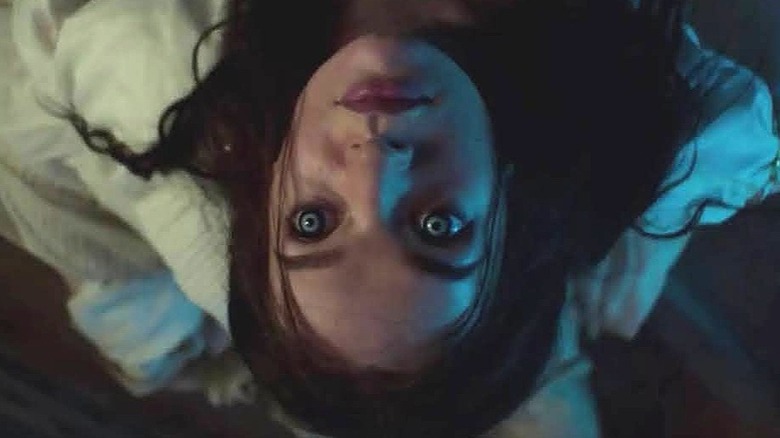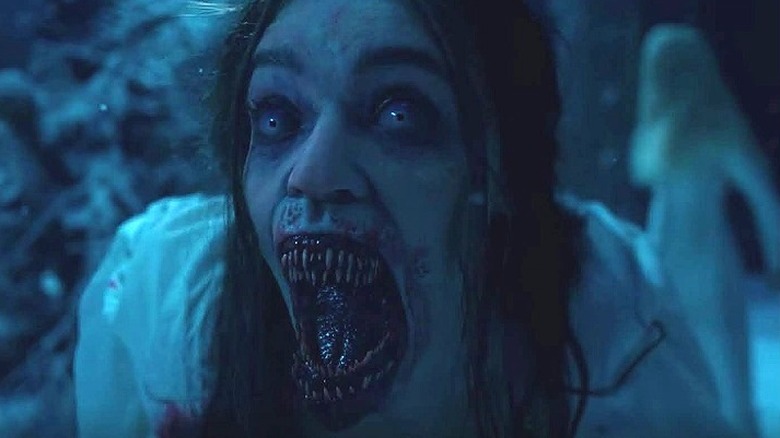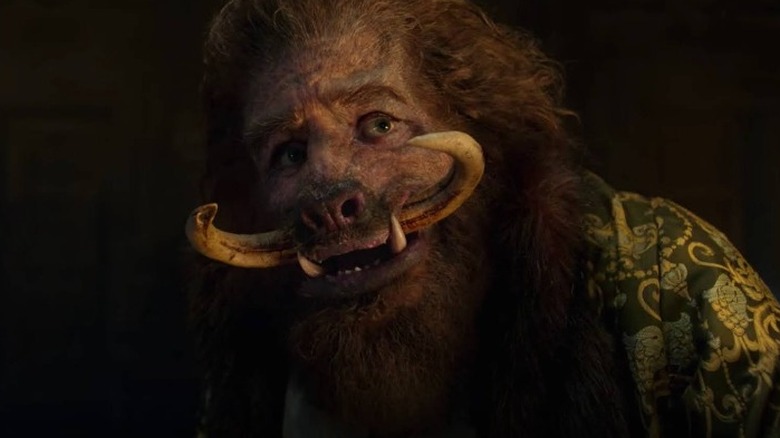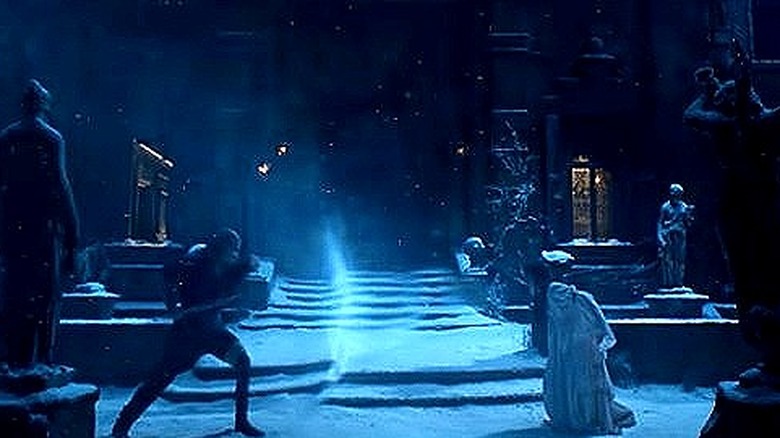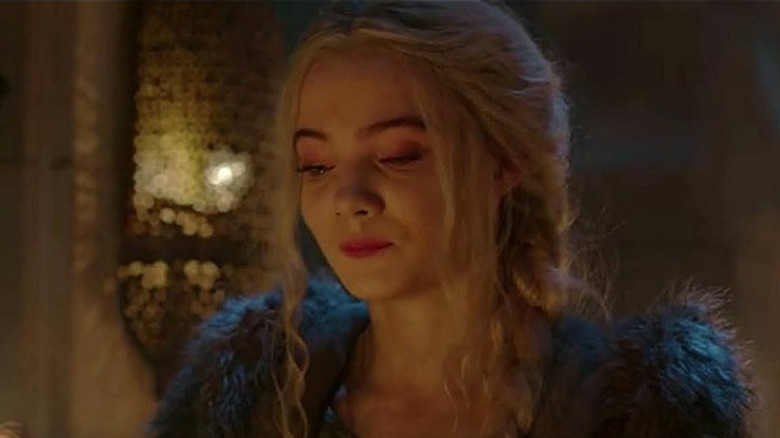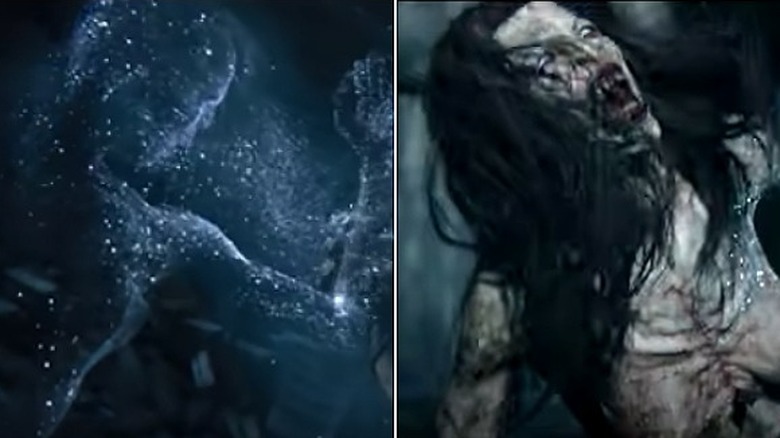The Bruxa In The Witcher Season 2 Explained
Unlike "The Witcher" Season 2's fearsome forest monster, the Leshen, the series' rendition of the vampiric Bruxa (aka Vereena, portrayed by Agnes Born) appears to be drawn directly from Andrzej Sapkowski's books, as opposed to the CD Projekt RED games. In the story collection "The Last Wish," Geralt encounters the monster and her equally monstrous (if human) lover Nivellen in the story "A Grain of Truth," which bears more than a little resemblance to "Beauty and the Beast," a general reference Sapkowski has cited as influencing his work (via Lithub).
In addition to introducing two brand new cast members and characters to the mysterious and often menacing universe of "The Witcher," the series' decision to start Season 2 off with one of Sapkowski's most thematically relevant short stories helps the adaptation further explore the unspoken rules that govern Geralt's understanding of both his job and the mechanics of The Continent. Moreover, for fans of both the games (in which the monster is featured) and the books, it allowed the series to engage in a little light fan service without compromising the integrity of its narrative. "This is by far my favorite short story from the Witcher series," wrote a fan on the series subreddit, while another said (in reference to the Season 2 trailer), "Looks ******* great! I love the bat aesthetics..." (via Reddit).
So, what exactly is the simultaneously feared and beloved Bruxa all about, and how does she factor into both Sapkowski's stories and Lauren S. Hissrich's dazzling adaptation?
Sapkowski appears to have been inspired by Portuguese mythology
Andrzej Sapkowski implied during his Lithub interview that his Bruxa were inspired by the Bruxsa of Portuguese folklore and mythology. As the writer and vampire historian Lyn Gibson explains, these Portuguese blood-suckers are a little different from the vampires of Eastern European (and, later, Western) mythology. "The Bruxsa," she explains, "mostly females, were said to have been witches in their mortal lives making them difficult to detect and nearly impossible to kill."
This certainly seems in keeping with the Bruxa of "The Witcher," who proves a more than worthy opponent to the skilled Geralt. As Gibson reveals, the Bruxsa are unaffected by sunlight, most active between midnight and 2 a.m. (as Vereena appears to be in the series), and harbor an insatiable thirst for the blood of children, though they're also "attracted to hunting the male human."
The witch-vampire-shape shifter hybrid of Portuguese mythology — like the "witches" that permeated the rest of Europe in fits and bursts throughout the 15th-17th centuries — likely stemmed from a combination of religious fervor and competition during The Inquisition (via The Guardian), and a general mistrust of women who strayed outside of the societal norms of the time, among other factors. But regardless of what inspired the monster's original creation (and our subsequent fascination with it), it's clear that both Sapkowski and Hissrich had her underlying subtext in mind when it came to their respective explorations of her being.
How does The Bruxa work in Sapkowski's story A Grain of Truth?
In "A Grain of Truth," Geralt meets a creature named Nivellen who appears to be a boar-like monster, but is actually a man cursed to live as "a monster in a monster's skin," since he was already "a monster in human skin." In his youth, at the behest of his terrible friends, Nivellen raped a priestess, who subsequently took her own life after casting a powerful spell. Forced to live alone thanks to his frightening appearance, he'd long given up on attempting to break the curse.
Referencing the oft-told fairytales about how "pretty girls" can transform "frogs into princes," Nivellen tried for years to break the spell with the help of true love. Though he once thought there might be "a grain of truth" to the folktales (hence the title of the short story), his inability to transform back even after engaging in several surprisingly good relationships with women caused him to give up. Enter: Vereena. Nivellen may not know exactly what she is, but he's nonetheless aware of, and in denial about, the fact she poses a serious threat to innocent villagers and travelers.
When Geralt unwittingly runs into Vereena upon his departure from Nivellen's enchanted home, he quickly discovers she's a bloodthirsty Bruxa, and a tense and well-matched battle ensues. Ultimately, it's Nivellen who disables his lover just long enough for Geralt to cut off her head before she's able to reciprocate Nivellen's betrayal. His curse is lifted, not by the power of true love, but by the power of the loss of it, and the shedding of his true love's blood. Thus, the grain of truth in the stories wasn't about the ability of pretty girls to transform beasts, but about the "mighty power" contained in both true love and blood.
How does The Bruxa work in the Netflix adaptation?
When Geralt says he'd rather use his Child Surprise for "Bruxa bait" than give in to Destiny in Season 1, he unwittingly foreshadows the events of Season 2. Although Ciri isn't present during Geralt's encounter with the monster in "A Grain of Truth," she plays a key role in Netflix's adaptation of the story.
Geralt ends up at Nivellen's (Kristofer Hivju) whilst looking for a place to stay for the night for himself and Ciri. He takes her to a village he's surprised to find largely abandoned and ends up stumbling upon his "old friend" Nivellen on its outskirts. Just like in the short story, Nivellen has been carrying on a relationship with Vereena, protecting the secret of her existence, and keeping her alive despite the fact that she's been mercilessly feeding on travelers and villagers. Although the ensuing fight between Vereena and Geralt plays out nearly shot-for-shot the way it does in the book, the addition of Ciri — and her interaction with Vereena — helps the series foreground one of its ongoing themes.
When the curious Vereena pops in on a surprised Ciri, their conversation touches on what exactly makes a monster. "Monsters do bad things to people," Ciri says in an attempt to define the term, to which Vereena replies, "Humans do bad things to everybody." The Bruxa also asks Ciri if she's a monster solely because she's "different." Our initial introduction to the bloodthirsty Bruxa is one of sympathy laced with an appreciation for the importance of how perspective operates on The Continent. Humans do, after all, do bad things to everybody. And yet, the Bruxa ultimately reveals herself to be a genuine monster, despite her initial garnering of Ciri's trust and empathy. When cornered, she threatens to kill the young protagonist and nearly kills the man she supposedly loves, as well.
A Grain of Truth asks viewers to think about what makes a monster
Vereena's simultaneous bloodlust and vulnerability is yet another example of "The Witcher" world's emphasis on duality and relativity. Just as Nilfgaard sees its invasion of the North, its quest for Ciri, and its unstoppable conquering of kingdoms as in-keeping with a cause it believes to be just and necessary for the survival of The Continent, Vereena's understanding of her behavior and existence differs wildly from Geralt's. Although Geralt said, in Season 1, that he doesn't kill "intelligent creatures," it's clear that Vereena is, for all her faults — you know, like the whole killing innocent children thing — a highly intelligent creature. So where exactly does this Witcher draw the line, and what does it take to move it?
That's exactly the question both the book and the Netflix version of "A Grain of Truth" seek to answer for the audience. "Monsters are born of deeds done," Nivellen tells Ciri on the series, "unforgivable ones." At the time, Ciri doesn't know that this seemingly lovable boar-man was cursed for raping a powerful priestess, and not — as he initially tells her — for merely destroying a temple. She has a hard time seeing her new friend as a monster, but when he's revealed to be both a rapist and a man willing to let innocent villagers die in order to feed his own companionship needs, both Ciri and Geralt turn on him. Rape, the story makes clear, as well as the senseless slaughter of innocents in order to feed one's own needs (be they romantic or biological) are both unforgivable deeds, meaning that whoever engages in them is, in Geralt's book, a capital m Monster.
How does Netflix's Bruxa differ from CD Projekt RED's?
Similar to her depiction in Season 2, the Bruxa of CD Projekt RED's universe transforms from a beautiful woman into a ferocious, fang-filled monster. Although she takes the form of an enormous bat in both "The Last Wish" and its television adaptation, the Bruxa of the games is given a different alternative form, in that she can make herself "invisible" (or, at least, transparent). Both Bruxae have the ability to disable their opponent using sonic screams, and both temporarily lose their respective transformative abilities when wounded or hit. But while Netflix's battle-ready Bruxa appears fairly similar to the way she does in her human form (aside from her enormous, Sarlacc-like set of teeth), the game makes a clearer and more terrifying distinction between the monster's human and vampire forms.
In essence, the series stays truer to Sapkowski's depiction than the game does, which is to be expected considering the two different mediums' aesthetic intentions, available technologies, and subsequent burdens. Part of the motivation behind highlighting the Bruxa's story in Season 2 requires imbuing her with a shaky degree of sympathy via her ostensible vulnerability — a notion that her ferocious appearance in the games would undoubtedly complicate.
